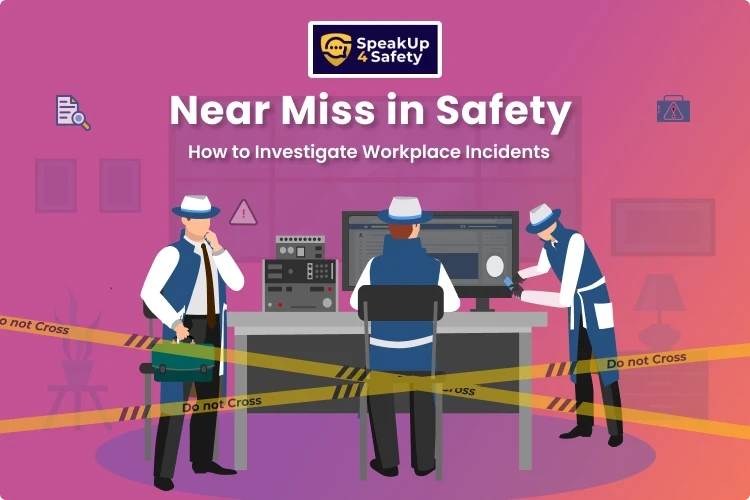Near Miss in Safety: How to Investigate Workplace Incidents

Speakup4Safety App in A Near Miss in Safety is an event where something almost went wrong but didn’t cause harm. It could be a falling box that narrowly missed a worker or a chemical leak stopped before exposure. Even though no injury occurs, the potential for danger is very real. Treating a near miss as “no harm done” ignores a valuable warning to fix hidden risks.
Investigating near misses is a core part of safety management. It strengthens workplace safety, prevents costly incidents, and builds a culture where employees feel responsible for each other’s well-being. In today’s world, digital incident reporting tools make this process faster, smarter, and more reliable.
This guide combines a step-by-step investigation process with modern digital tools to help safety managers turn near misses into lasting improvements.
Why Investigating Near Misses Matters
Early Hazard Detection with Context
A near miss is often the first visible sign of a system failure, for example, a forklift narrowly missing a pedestrian walkway signals poor traffic management.Investigating such cases allows safety teams to correct hidden hazards before they cause injury.
Turning Data into Prevention
Each reported near miss adds to a company’s incident reporting database. When patterns emerge, such as recurring slips in a particular area, organizations can implement targeted controls, like improved flooring or drainage, rather than relying on broad assumptions.
Building a Proactive Safety Culture
Employees are more likely to report near misses when they see corrective actions taken. This transforms reporting from a “paper exercise” into a trust-building practice that improves workplace safety and prevents underreporting.
Compliance as a Competitive Advantage
Meeting OSHA and ISO 45001 standards isn’t just about avoiding penalties. Companies that show a structured approach to near miss investigation often win stronger client trust, higher audit scores, and improved contractor safety ratings.
Step-by-Step Near Miss Investigation Process
The following step-by-step process will guide you in carrying out an effective near miss investigation.
Step 1: Immediate Response
Ensure the area is safe and secure.
Notify supervisors or the EHS team.
Preserve the scene to avoid losing evidence.
Step 2: Record the Near Miss
Use a structured near miss reporting form.
Capture details: time, location, activity, equipment involved, and people present.
Step 3: Gather Evidence & Information
interview witnesses to get multiple perspectives.
Review CCTV, machine logs, or digital sensors.
Collect environmental data (e.g., noise level, lighting, temperature).
Step 4: Conduct Root Cause Analysis (RCA)
Use 5 Whys or Fishbone diagrams to identify deeper causes.
Connecting near miss reports directly to RCA templates.
To learn more about Root Cause Analysis methods and best practices, you can check our blog on Root Cause Analysis .
Step 5: Assess Risk & Potential Impact
Ask: “What could have happened if this became an incident?”
Rate severity and likelihood (low, medium, high).
Step 6: Recommend Corrective & Preventive Actions
Suggest fixes: redesign processes, update equipment, provide additional training.
Assign tasks to responsible persons with deadlines.
Step 7: Share Findings & Close the Loop
Communicate lessons learned to the workforce.
Update policies, training, and procedures if necessary.
Track follow-up actions to confirm they’re effective.
Enhancing Investigations with SpeakUp4Safety
Near miss reporting is only effective when followed by timely investigation and corrective action. With SpeakUp4Safety , you can manage the entire process digitally, from capturing reports to tracking resolutions, in one secure platform
Fast, accessible reporting – Workers can file incidents directly from their mobile devices without delays.
Smart data capture – Hazard type, severity, location, and recurrence are automatically structured for easier analysis.
Centralized cloud records – All reports are securely stored and instantly accessible, making investigations faster and more transparent.
Investigation tools – Safety teams can assign follow-ups, track corrective actions, and document outcomes directly within the platform.
With SpeakUp4Safety, investigations move from reactive paperwork to a proactive process that uncovers root causes, shares lessons learned, and strengthens workplace safety culture
Turning Near Miss Reports into Actionable Safety Data
Collecting reports is only half the job, turning them into data is where real safety improvements happen. By analyzing structured near miss reports, organizations can track key metrics such as:
Near Miss Frequency Rate – Measure how often near misses occur compared to exposure hours.
Severity Potential – Assess how serious incidents could have been to prioritize high-risk hazards.
Recurrence Trends – Identify repeated issues with specific equipment, processes, or shifts.
Response Time – Monitor how quickly reports are investigated and corrective actions completed.
For example, one company’s dashboard revealed a spike in near misses during night shifts. By adjusting staffing levels and providing targeted training, they reduced risks significantly.
Compliance & Data Privacy in Near Miss Investigations
OSHA views near miss reporting as part of proactive risk management.
ISO 45001 requires investigation of near misses to strengthen safety systems.
GDPR principles apply: protect employee identities, allow anonymous reporting, and secure data storage.
Digital systems make compliance easier by timestamping, encrypting, and archiving all reports.
Technology Integration & Future of Near Miss Investigations
Mobile apps like the SpeakUp4Safety app let workers report hazards instantly, even offline.
EHS platforms connect near miss reports to wider safety dashboards for better visibility.
AI and machine learning detect patterns across sites, predicting risks before they escalate.
Conclusion
Every near miss is an opportunity to prevent real accidents. By following a structured investigation process and leveraging digital tools, organizations can turn small warnings into meaningful safety improvements.
Take your workplace safety to the next level, explore SpeakUp4Safety and start streamlining near miss reporting and investigations today. Contact SpeakUp4Safety to get started.
learn more : https://speakup4safetyapp.com/blog/near-miss-in-safety-how-to-investigate-workplace-incidents/







